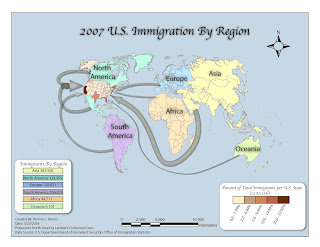Module 9 Lab: Flow Line Mapping
This weeks module covered flow line mapping. Flow maps are used to show movement of people, commodities, ideas, technology, wind, and ocean currents as well as many other phenomena between locations. In this lab, we focused specifically on a distributive flow map that mapped the proportion of immigrants into the United States from different regions of the world using population data from 2007.
According to the information given in our textbook, this map most directly aligns to the second subcategory of distributive flow maps. Each flow line is a different size, proportional to the number of immigrants traveling from its respective region. I determined the size of each line by applying a formula to the 2007 data for each region on an excel spreadsheet. Since visual hierarchy and a good figure-ground relationship are extremely important in flow line mapping, I stylized the flow lines with effects like drop shadow, 3D Extrude & Bevel, inner glow, and transparency to make them stand out. I added an outer glow to the region names for legibility and included the rest of my essential map elements.
Creating flow lines was by far the most daunting part of this lab. It took me a while to get the hang of editing the lines and making them seamless and accurate without covering any important map features. However, I did run into trouble while creating the converging lines. Because the original two North America flow lines are transparent, using three lines to make a proportional arrow to connect them created a darker space where they meet. I decided to leave the converging lines because it communicates the information better, but this is a design issue I hope to work thru for aesthetic purposes in the future.
Additionally, this map includes a normally distributed choropleth map of United States immigration by state. I created a continuous scale for this information. I appreciated my background knowledge of choropleth maps because otherwise this would have simply been an addition of data without true respect for its creation.




Comments
Post a Comment